Flutter, the next big thing
Flutter revolutionizes cross-platform app development with its simplicity, performance, and rich widget library. Backed by Google, this open-source SDK streamlines coding with Dart and empowers developers to create seamless, high-performing apps for iOS, Android, and beyond.

As an Android developer, for the last few years, I’ve tried React Native, which was quite hyped recently. My adventure with React Native was short-lived and I decided to ditch it in the favour of the Flutter.
What is Flutter?
Flutter is Google Open Source SDK used to develop applications in Dart for iOS, Android and Fuschia. The first version of Flutter came out a year ago and since then the project has been constantly growing (as of moment of writing, current version on repo is 0.9.2).Flutter has also broken into the top 50 active software repositories on GitHub:

How does it work ?
Unlike React Native which communicates with native platform and wraps OEM widgets, Flutter deploys its own engine which opens the terminal to native platform and communicates with it using channels and it draws widgets using its own rendering engine, Skia, inside FlutterActivity or FlutterViewController.
Why Flutter ?
Installation process is quite simple.
- Supported by the major IDEs like InteliJ,Android Studio and VSCode.
- Dart which has a lot of features of the most popular programming languages (Java, Swift, Javascript, C# and etc.) like the types, await/async, futures and streams. I really missed types while I was working with React Native.
- Instant run takes less than a second and it keeps the current screen and state.
- Dartfmt makes your code consistently formatted no matter which IDE you use.
- Autocomplete is really good and speeds things up.
- Great source-code documentation, which is one click away.
- Out-of-the-box support and large number of widgets.
- Great community and the fact that it’s backed by Google.
- Creating a project is really simple and doesn’t involve writing a lot of boilerplate and adding a lot of dependencies, unlike React Native.
- Routing out-of-the-the-box .Unlike React Native where you have a handful of libraries Flutter comes with Navigator which is quite simple to use and well documented.
Why not Flutter ?
- Currently, Flutter lacks WebView and Maps support for iOS but it’s work in progress and probably, by the end of the year, it will be rolled out.
- Widgets deep nesting which can become quite troublesome if you are not careful.
Conclusion
Flutter might look like a young lad but it’s taking really big steps towards the industry while shaping it and bringing a lot of cool stuff, which takes this cross-platformer head to head with native platforms.



